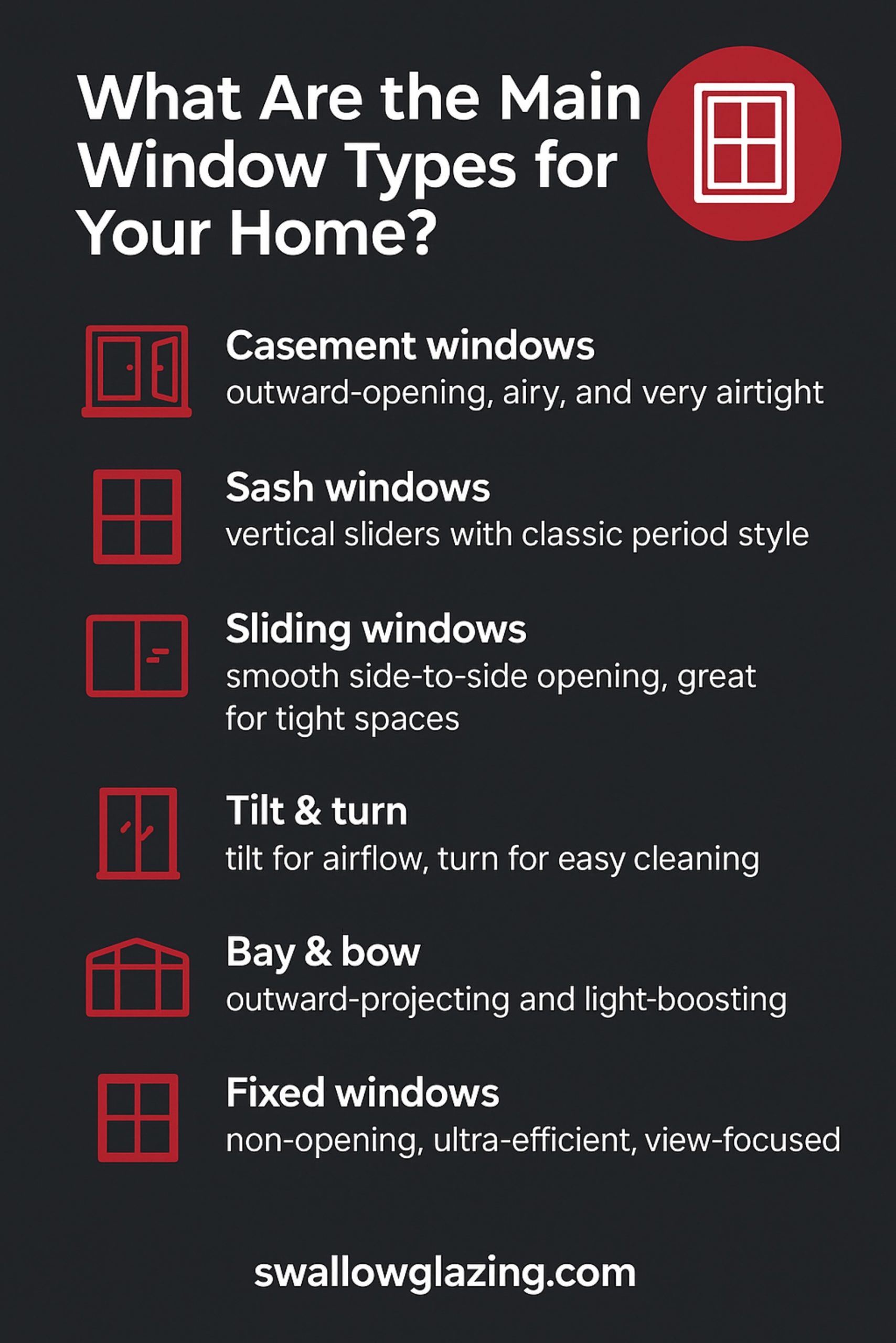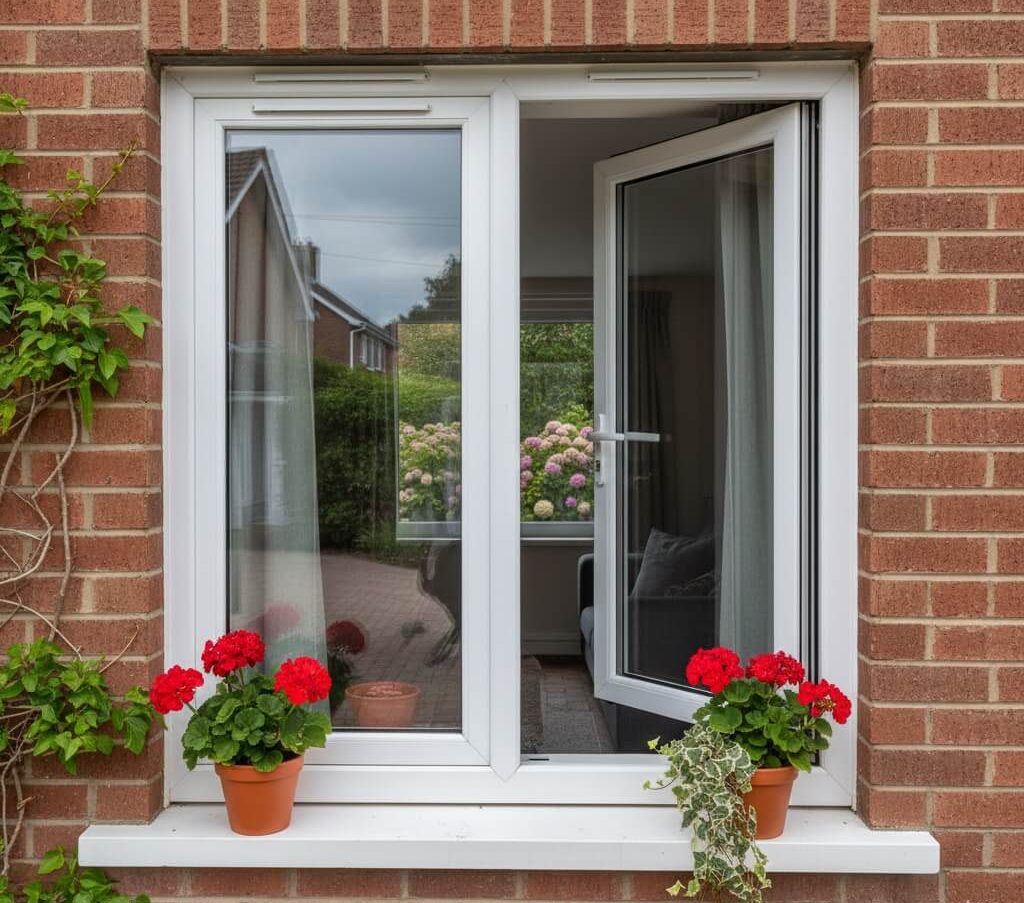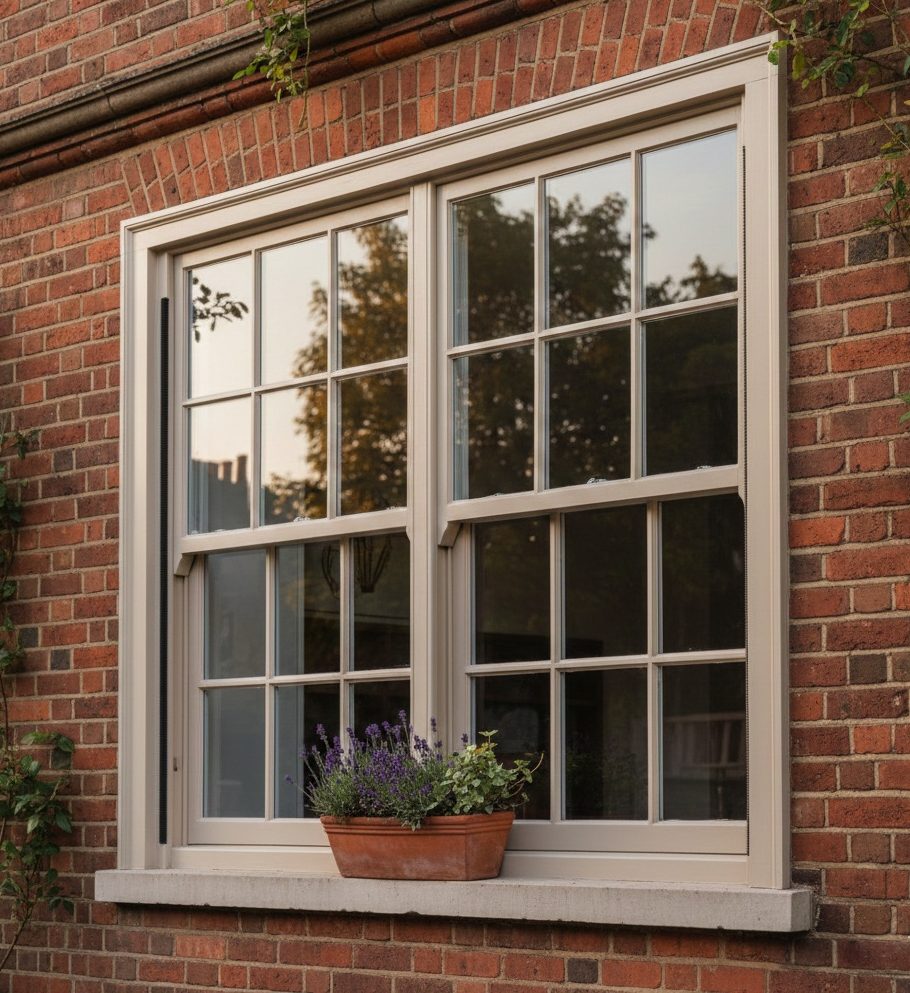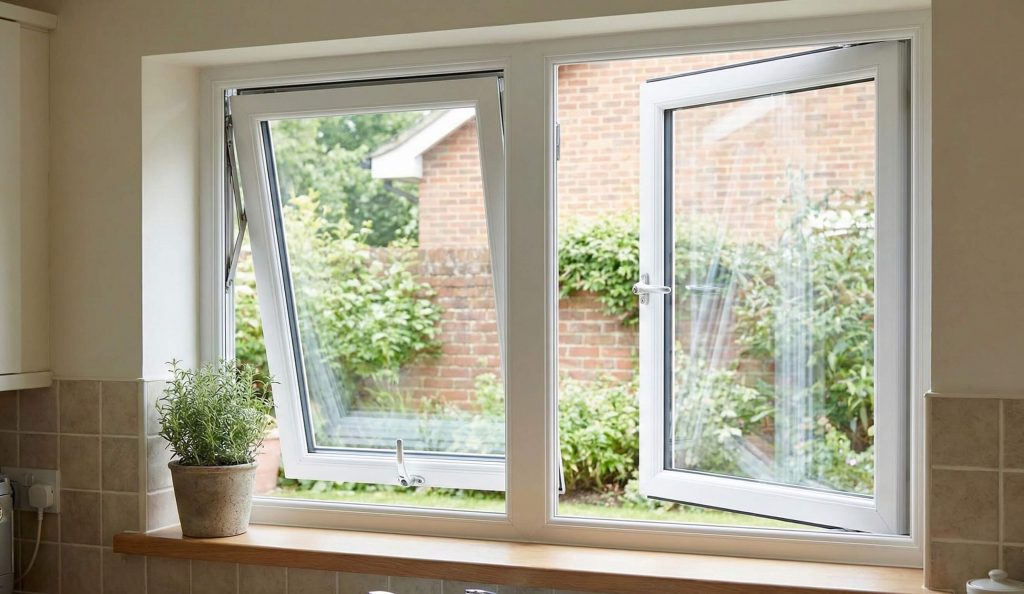With UK residents spending over 95% of their time indoors, and 66% at home, choosing high-performance windows is essential for creating a comfortable, energy-efficient living environment.
Windows transform your home in ways you might not even realise. Windows influence energy efficiency, natural light, ventilation, security, and the overall comfort of your home. Common styles in UK homes include casement, sash, sliding, tilt-and-turn, bay/bow, and fixed windows. Your choice should reflect your property’s architectural style, thermal requirements, and maintenance preferences.
Key Takeaways
- Window choice significantly impacts your home’s energy efficiency, with proper selection potentially reducing heating bills by up to 25%.
- Different window styles serve specific functions; casement windows offer excellent ventilation, while tilt-and-turn windows provide superior security and cleaning access.
- Frame materials determine longevity and maintenance needs: uPVC is low-maintenance, aluminium offers slim profiles, and timber provides traditional aesthetics.
What Are the Main Types of Window?
Each window style offers different benefits for ventilation, security, and aesthetics. We’re going to explore the most popular options for UK homes.

Casement Windows
Casement windows are among the most versatile and widely installed styles in the UK. They can accommodate single, double, triple, or multi-panel designs, depending on the aperture size.
Openers can be positioned on one side, both sides, the top, or across the full frame, offering controlled ventilation. Modern casement windows feature compression-sealed sashes that deliver superior airtightness, achieving BS 6375-1 weather performance standards. This ensures energy efficiency, draught prevention, and reliable thermal insulation.
Casement windows are suitable for most property types, including period cottages, Victorian terraces, and contemporary homes. Their simplicity, flexibility, and high-performance capabilities make them a top choice for uPVC, timber, and aluminium installations.

These Are the Several Types of Casement Windows
| Type | Description | Best For |
|---|---|---|
| Side-hung | Hinged at the side, swinging outward | Most common, versatile application |
| Top-hung | Hinged at top, opening from bottom | Areas where rain protection is important |
| Bottom-hung | Hinged at bottom, opening from top | Upper floors, where safety is a concern |
| Flush casement | Sits flush with frame when closed | Period properties, contemporary aesthetics |
| French casement | Double casements with no central mullion | Maximum ventilation and views |
Casement windows work brilliantly in most architectural styles, from period cottages to contemporary homes. Their simplicity and efficiency make them a popular choice for uPVC windows across the UK.
Sash Windows
Sash windows are often considered the most aesthetically pleasing window style, particularly in Georgian, Victorian, and Edwardian properties, where they can significantly enhance property value.
Traditional sash windows consist of two vertically sliding panels (sashes), often balanced by cords and weights, allowing ventilation from both the top and bottom simultaneously. This clever design predates modern air conditioning and extractor fans yet remains highly effective for natural airflow.
Older sash windows often require significant maintenance. Frames can warp, cords may fray, and panels can rattle or stick, reducing insulation and comfort. Many end up being painted shut over time.
Modern sash windows have addressed these issues with spiral balances, brush seals for airtightness, and double-glazing options for improved thermal efficiency. Contemporary designs retain period-accurate aesthetics and comply with conservation area and listed building requirements, where like-for-like replacements are often mandatory.
Well-installed modern sash windows not only improve energy efficiency but also maintain the historic character of a property and can enhance market appeal.

These Are a Few Different Types of Sash Windows
| Type | Description | Best For |
|---|---|---|
| Single-Hung | One sash pane slides while the other remains fixed | Traditional properties where partial ventilation is sufficient |
| Double-Hung | Both sash panes slide, allowing ventilation at top and bottom | Period homes needing full airflow and natural ventilation |
| Dummy Sash | Fixed sashes styled to look like a normal sash window | Creating symmetry or equal sightlines on a property |
Sliding Windows
Sliding windows operate horizontally, with one pane gliding behind another along top and bottom tracks. They are ideal where outward-opening windows would be impractical, such as above kitchen sinks or adjacent to walkways.
Aluminium sliding windows feature slim frames that maximise glass area and natural light. When combined with double or triple glazing, they provide excellent thermal and acoustic performance. These windows are particularly suited to modern and minimalist homes, though they can also serve as secondary windows in traditional properties.
Sliding windows meet performance standards under BS 6375-1, ensuring resistance to air leakage, water ingress, and wind pressure.
Tilt-and-Turn Windows
Tilt-and-turn windows offer a highly practical solution for modern properties, combining dual functionality. In tilt mode, the window opens from the top for secure ventilation. In turn mode, it swings fully inward, allowing easy cleaning from inside, even on upper floors.
These windows provide exceptional security with multi-point locking systems and excellent airtightness through robust perimeter seals. Tilt-and-turn frames tend to be thicker than other window styles, making them less suitable for period properties but ideal for contemporary homes, apartments, and post-1960s developments.

Bay and Bow Windows
Bay and bow windows project outward from a property’s main wall, increasing interior space and admitting light from multiple angles. Bay windows typically have angular sides with a flat front, often extending to the ground with brickwork. Bow windows are curved, composed of four or more panels, and generally do not require foundation extension.
These windows enhance natural light, create a feeling of spaciousness, and provide panoramic views. They are considered architectural features that can boost a property’s kerb appeal. Bay windows at the front of a house may require planning permission, while replacement of existing bays often falls under permitted development rights.

Fixed Windows
Fixed windows do not open, making them an excellent option for energy efficiency, security, and uninterrupted views. Without moving parts, there are no gaps for air leakage, ensuring superior insulation.
Fixed windows are often combined with operable windows to meet ventilation and emergency egress requirements. They are ideal for high-level glazing, stairwells, or feature walls where operability is not required.
Window Frame Materials
The right frame material significantly affects your windows’ appearance, performance, and maintenance requirements.
uPVC Frames
uPVC dominates the UK replacement window market due to:
- Excellent value for money
- Minimal maintenance requirements
- Good thermal performance
- Availability in various colours and wood-effect finishes
Modern uPVC windows have evolved considerably from earlier generations, now offering slimmer profiles and more authentic finishes for homeowners seeking efficiency without compromising aesthetics.
Aluminium Frames
Aluminium frames have surged in popularity for contemporary properties. Their standout features include:
- Exceptionally slim sightlines maximising glass area
- Outstanding structural strength allowing larger glazed areas
- Superior durability and weather resistance
- Contemporary aesthetic with powder-coated finish options
Quality aluminium windows with proper thermal breaks deliver excellent energy efficiency despite their slender profiles, making them ideal for modern architectural designs.
Timber Frames
Timber windows offer unmatched natural beauty and heritage appeal:
- Authentic period aesthetics for traditional properties
- Best environmental profile when sustainably sourced
- Natural insulation properties
- Repairability throughout their lifespan
Modern factory-finished timber has overcome many historical maintenance issues through advanced treatment processes, though it still requires more attention than synthetic alternatives.
Composite Frames
Composite windows combine materials for maximum benefits, typically featuring timber interiors with aluminium exteriors. These hybrid solutions deliver the warmth and aesthetics of wood internally with weather resistance and low maintenance externally.
Energy Efficiency and Performance Features
Window energy performance has advanced dramatically, with several key features determining efficiency.
Glazing Options
Double glazing has become standard in UK homes, with 89% now featuring full double glazing according to the 2023-24 English Housing Survey. The basic construction includes:
- Two glass panes separated by a spacer
- Argon gas filling the gap for improved insulation
- Low-emissivity (Low-E) coatings reflecting heat back into the home
Triple glazing adds a third pane and additional gas layer, further enhancing thermal and acoustic performance, increasingly important for properties in noisy areas or ultra-low energy buildings.
Frame Quality and U-Values
A window’s thermal performance is measured by its U-value, the rate at which it transmits heat (lower is better). Current UK Building Regulations (Part L) require new-build windows to achieve U-values of 1.6 W/m²·K or better.
The highest performing windows combine quality frames with excellent glazing and professional installation to minimise heat loss and prevent cold spots around edges.
How to Choose the Right Window Style
Selecting the perfect windows means balancing aesthetics, performance, and practical considerations.
Match your windows to your home’s architectural era:
| House Style | Recommended Window Types | Suitable Materials |
|---|---|---|
| Victorian/Georgian | Sash or casement with period details | Timber, quality uPVC with authentic details |
| 1930s semi-detached | Bay windows, casements | uPVC, timber |
| Modern/contemporary | Large sliding or fixed with minimal frames | Aluminium, composite |
| Cottage/rural | Flush casement, often with leaded details | Timber, composite, quality uPVC |
Consider practical requirements like easy cleaning access for upper floors, adequate ventilation for kitchens and bathrooms, and emergency egress for bedrooms.
All replacement windows must comply with several regulations:
- Part L: Energy efficiency (U-values of 1.6 W/m²K or better)
- Part F: Ventilation requirements (including background ventilators)
- Part B: Escape requirements for bedrooms (minimum openable area of 0.33m²)
- Part Q: Security standards for accessible windows (typically PAS 24 certified)
Conservation areas and listed buildings have additional requirements; always check with your local authority before proceeding.
Window Maintenance and Replacement
Quality windows should last 20-30 years, though this varies by material and maintenance. Timber frames may need repainting every 5-8 years, but can last generations if well-maintained.
uPVC typically needs minimal maintenance beyond cleaning, but may eventually discolour or develop mechanical issues after 20-30 years. Aluminium frames can last 30+ years with little maintenance.

Conclusion
With energy prices continuing to rise, investing in quality windows will enhance comfort while reducing bills for years to come. Ready to find the perfect windows for your home? Our FENSA-registered team can guide you through all the options and help you balance style, performance, and value for your specific property.
FAQs
Which window type provides the best energy efficiency for UK homes?
Tilt and turn windows typically offer the best energy efficiency due to their multi-point locking systems, creating exceptionally tight seals. However, any well-manufactured window style with quality glazing and proper installation can achieve excellent thermal performance.
How long should quality windows last in British weather conditions?
Quality windows should last 20-30 years with proper maintenance. uPVC windows typically last 25+ years, aluminium 30+ years, and well-maintained timber windows can last 60+ years with periodic refurbishment of the most exposed elements.
Do I need planning permission to replace my windows?
Most like-for-like window replacements don’t require planning permission. However, you’ll need permission if your home is listed, in a conservation area with Article 4 directions, or if making significant changes like installing bay windows where none existed.
Which window materials require the least maintenance?
uPVC and aluminium windows require minimal maintenance, generally just cleaning and occasional hardware lubrication. Timber requires the most attention with periodic checking of finishes and occasional repainting/resealing.
What should I look for on window energy labels when comparing products?
Look for the window’s U-value (lower is better), with current regulations requiring 1.6 W/m²·K or better. Also check air permeability class (higher is better), water tightness rating, and wind resistance class, especially important for exposed or coastal locations.


